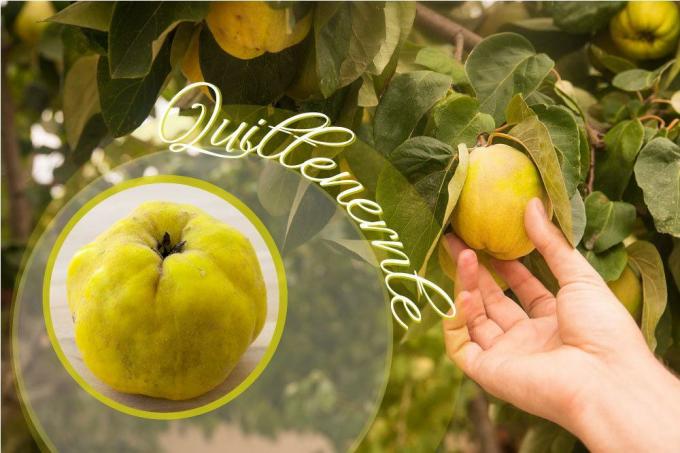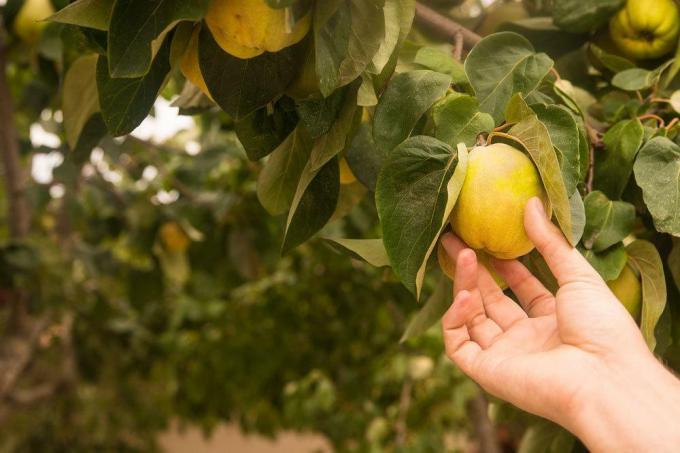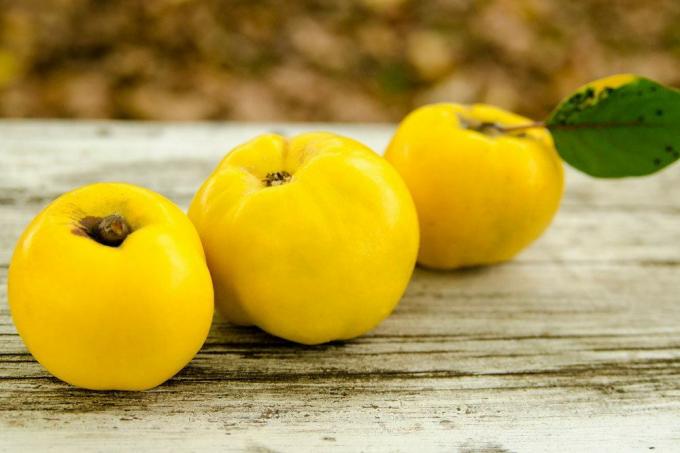
table of contents
- Harvest time
- harvest
- use
Quinces (bot. Cydonia oblonga) are among the most popular fruits in German gardens thanks to their fresh, slightly bitter lemon aroma. The fruit, which comes from the Caucasus, is mainly known in the Mediterranean region and has no problems to thrive in Germany, which then leads to the popular quiet harvest. You also have a quince tree in your garden and are now wondering when you can harvest the furry, yellow quinces?
Harvest time
The harvest time of the quince is strongly dependent on the location and the weather. Since it actually comes from warmer areas where it can ripen faster, the fruits can only be harvested at the end of the season. Cydonia oblonga has different harvest times that are close together and tend to merge into one another. When you can harvest the quinces is listed below.

the beginning of October
At the beginning of October, the quiet harvest in Germany is only possible if the weather cooperates and the care is right. Quinces are extremely sun-hungry and do not tolerate the cold well. For this reason, the fruits in southwest Germany such as Baden-Württemberg, the Palatinate and western Bavaria often show up at the beginning of October. However, if the weather is particularly rough, this point in time can shift further back.
Mid to late October
The rest of Germany usually only sees quinces from the second half of October and even often at the end of October and less often at the beginning of November. The further north the quince grows, the longer it takes for the fruit to ripen. It also takes longer at high altitudes that are cooler than the flatlands.
In summary, October is the typical harvest month for Cydonia oblonga and thus the quince is one of the last fruits of the year. This makes them a fruit boost over the winter due to their numerous uses.
Tip: The individual harvest times of the quince can be extended if you choose late- and early-ripening varieties. For example, you can choose one variety that can be harvested at the end of September while another In mid-October and again another one at the end of October is ready, which clearly shows the potential yields elevated.
harvest
When to harvest during harvest time
In the case of the quince, the harvest time does not directly describe when it should be harvested, but only the period in which the harvest is possible. In the case of "honey apples", the following points must be observed, which determine the perfect time for harvest.
- Color of fruit
- Fluff of the fruit
- Night frosts

use
At the beginning of the fruit formation and all the way up to harvest, the quince fruits are in kept a light green tone, which becomes more and more yellowish from the end of September and the beginning of October colors. As soon as the fruits have turned yellow, they can be harvested. However, they intensify in taste if they stick for a while. This is where night frosts come into play. You can postpone the quiet harvest, preferably until the characteristic fluff has fallen off, but harvest immediately when the first night frosts set in. The cold causes a strong loss of aroma.
Furthermore, the use is crucial:
- jam and Jelly: immediate harvest, as this is when the pectin content is highest
- Fruit juices: as late as possible, otherwise the aroma for the juice is too weak
- Compote: depending on the desired taste intensity
- Liqueur: something earlier like juice, shouldn't be exposed to frost

These are only vague instructions, but they help to get the highest flavor potential out of the fruit. In this sense, the time of harvest is up to you, you just have to pay attention to the color of the quinces and the first night frost so that you harvest neither too early nor too late. A big advantage of the fruits is that they can be left to ripen on the windowsill for up to eight weeks. You should not touch any other fruits, otherwise the ripening process will be negatively affected and possible pressure points will arise, as quinces are extremely sensitive.
Tip: If you want some of your quince harvest for a long time to come, or if you had a high yielding harvest, you should save the rest. At a temperature of around 2 ° C, the fruits can be stored for up to two months without any problems, which is sufficient for most of the winter.



